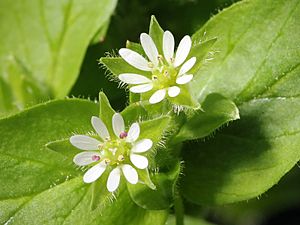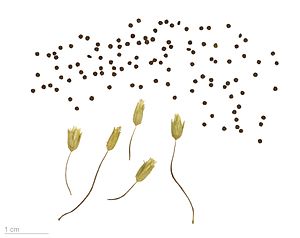Common chickweed facts for kids
Quick facts for kids Common chickweed |
|
|---|---|
 |
|
| Flowers of the common chickweed | |
| Scientific classification | |
| Genus: |
Stellaria
|
| Species: |
media
|
| Synonyms | |
|
Alsine media L. |
|
Stellaria media, often called chickweed, is a common flowering plant. It can grow for one year (annual) or many years (perennial). This plant is originally from Europe and Asia, but you can find it all over the world now. People use chickweed as a cooling herbal remedy. It is also grown as a vegetable and as a ground cover. Both humans and chickens can eat it! Sometimes it's called common chickweed to tell it apart from other plants with similar names. Other names for it include chickenwort, craches, maruns, and winterweed. The plant usually starts growing in autumn or late winter. It then spreads out to form large mats of leaves.
Contents
What Does Chickweed Look Like?
Chickweed is an annual in cold places. But in warmer areas, it stays green all year and is a perennial plant. It has weak, thin stems that can grow up to 40 centimeters (about 16 inches) long. The stems have a single line of fine hairs.
The leaves are oval-shaped and grow in pairs opposite each other on the stem. The lower leaves have small stalks. Chickweed flowers are small and white. They have five petals, but each petal is so deeply split that it looks like ten petals! Some chickweed plants might not have any petals at all. Each flower usually has three stamens (the parts that make pollen) and three styles (parts of the female flower). The flowers quickly turn into small seed pods called capsules. You might see flowers and seed pods on the same plant at the same time.
Plants in the Cerastium group look a lot like chickweed. They are in the same plant family. However, Cerastium plants have hairs all over their stems, not just in one line. This helps you tell them apart!
Where Does Chickweed Grow?
Chickweed is found all over Asia, Europe, North America, and many other parts of the world. It grows well in many places. You can often find it in lawns, open fields, and disturbed areas. It likes places where the ground has been moved or dug up.
Who Eats Chickweed?
Many animals enjoy eating chickweed. The larvae (young forms) of certain moths, like the yellow shell moth in Europe, eat it. In North America, the pale-banded dart and dusky cutworm moths also feed on chickweed. The dainty sulphur butterfly also likes to eat it.
Chickweed is also a food for humans! It is safe to eat and full of good nutrients. People often eat it raw in salads. In Japan, chickweed is one of the plants used in a special spring festival dish called Nanakusa-no-sekku. Chickens and wild birds also love to eat chickweed.
Is Chickweed Safe to Eat?
Chickweed has natural chemicals called saponins. These can be harmful to some animals, especially fish, if they eat a lot of them. But it's very unlikely to affect most land animals because you would need to eat a huge amount. However, it is not recommended for pregnant or breastfeeding mothers. It's always a good idea to check with an adult before eating any wild plants.
Also, be careful not to confuse chickweed with a plant called Euphorbia. Some Euphorbia plants can be mildly harmful.
Traditional Uses of Chickweed
For a long time, people have used chickweed in folk medicine. It has been used to help with itchy skin and breathing problems. In the 1600s, a herbalist named John Gerard suggested it could help with skin conditions like mange.
Today, some herbalists use it for things like low iron (because it has iron), skin problems, bronchitis, and joint pain. They also use it for period pain. But it's important to know that not all of these uses have been proven by science. The Ainu people in Japan used chickweed to treat bruises and sore bones. They would soak the stems in hot water and then put them on the affected areas.
Why is it Called "Stellaria media"?
The name Stellaria comes from the word 'stellar', which means 'star'. This refers to the star-like shape of its small white flowers. The word Media comes from Latin. It means 'between', 'intermediate', or 'mid-sized'. So, its scientific name describes its star-shaped flowers and its medium size.
See also
 In Spanish: Capiquí para niños
In Spanish: Capiquí para niños



